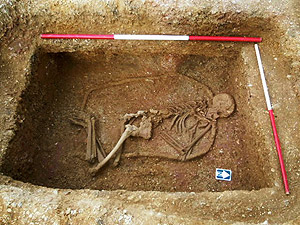Iron Age Yorkshire – Pocklington Iron Age cemetery
Archaeological investigations ahead of a housing development at the south-east edge of Pocklington, East Yorkshire, In fields on Burnby Lane opposite the grounds of the local cricket club have uncovered the remains of 76 Arras-style square barrows and 138 burials dating from the Middle to Late Iron Age, as well as 18 Anglian interments. Work on the 3.6 ha site was planned to continue until at least Christmas 2015 so these numbers are bound to rise still further.
The skeletons found in the burials were of men, women and children, mostly – though not all – crouched, typically facing either east or west. Finds with the skeletons so far have included a sword, a shield, two bracelets, two brooches, pendants, glass beads and pots – all typical of the Arras culture. A scan of the site has also revealed a double ditched trackway associated with a square enclosure and eight probable square barrows immediately to the north. Post-excavation conservation and assessment, including strontium-isotope, DNA and carbon-nitrogen protein analysis, began in 2016.
Arras-style barrows are not unknown in the area. A system of rectangular enclosures and probable square barrows, first seen from the air and reported was later identified as a possible La Tène burial ground. More detailed investigation revealed from 10-20 barrows to the south-west of the Burnby Lane site and another group 700m to the south-south-west. Later aerial photography confirmed two further groups of barrows 200m and 600m south-south-west respectively from the Burnby Lane cemetery.
Aerial photography in 1975 identified a further three square barrows complete with central grave pits and possibly another three at Barnby Moor, 1.4km to the west-south-west. Two La Tène crouched burials were revealed by a rescue excavation in a gravel quarry at Hayton Field Farm, 1.6km to the south-east Moving to the north side of Pocklington, aerial photography again revealed a single barrow 1.7km north-west of Burnby Lane and a little further on, 2km to the north-north-west, cropmarks of two parallel linear features and further possible square barrows. However, even within this previously established context, the discoveries at Burnby Lane easily represent the largest single concentration of Arras-style burials in the area and constitute a major cemetery.
The so-called Arras culture associated with the Iron Age people the Parisi, c. 500-300 BC, is named after the Wolds type site of Arras in East Yorkshire, to the east of Market Weighton, where a large cemetery was discovered at the beginning of the 19th century. These are typified, as at Pocklington, by crouched burials, generally aligned north to south, with carts/chariots and associated fittings, weaponry and jewels decorated in the La Tène style, in barrows surrounded by characteristic square ditched enclosures.

Pocklington Iron Age cemetery: shield burial (Early Iron Age c. 500-300 BC)
Many hundreds of these, grouped into cemeteries, have since been found, not only at Arras, but at Cowlam, Dane’s Graves, Driffield, Eastburn, Hunmanby, Huntow, Pexton Moor and Sawdon – all in East Yorkshire. These recent major discoveries at Pocklington will unquestionably make a significant contribution to this record and to our understanding of Arras culture.